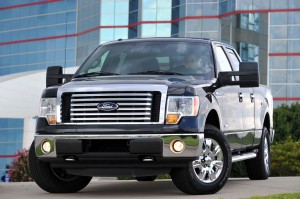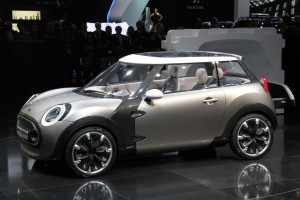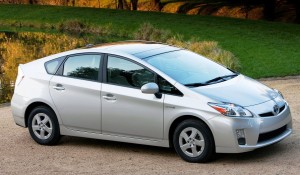With fuel prices spiking — and some markets are now reporting figures of more than $4 a gallon — plenty of folks are rethinking how small they should go.
Even before the latest crisis in Libya sent global petroleum markets into turmoil, American motorists were starting to downsize. February sales numbers showed a significant spike in demand for compacts and subcompacts.
But last month also saw a surge in sales of big pickups and SUVs, as well. Old habits die hard, especially in a market where bigger is generally seen as better.
But the figures also suggest that for many American motorists, downsizing is downright difficult. Trading in that big SUV for a compact sedan just might not work for many buyers, especially those with large families, or for those who might need to tow or carry lots of “stuff” for business or pleasure.
Is downsizing right for you? The question isn’t as easy as it might seem. For one thing, there are both practical and emotional factors to consider.
Americans are becoming increasingly conscious of the environment and there are many who believe that anything they can do to reduce the use of fossil fuels – and to limit the creation of global warming gases – is the right thing to do. Many would downsize – or switch to alternative propulsion systems, like hybrids – even if fuel costs fell.
Others are politically motivated, and want to curb the nation’s dependence on petroleum sourced from less-than-friendly producers, like Venezuela, Iran or Libya.
Most motorists fall into the practical category, however, and for them, the decision on what to buy is at least partially based on dollars and sense, as well as functional issues related to what they need from the family chariot. But it’s easy to overstate the impact that downsizing might have on the household budget.
If you’re driving an old SUV getting 15 miles per gallon, there’s no question you’d be in for big savings by switching to even a midsize sedan averaging 30 mpg. Based on the typical 15,000 miles a year driven by the average American motorist, the ute would burn 1,000 gallons annually, worth $4,000 if we reach the $4 mark, as many experts anticipate in the coming months. That sedan would burn just 500 gallons, worth $2,000, a huge savings.

Ford now offers a V6 EcoBoost in the F150 pickup that delivers both better mileage and more horsepower than the standard 5.0-liter V8.
So why not go even smaller, perhaps to one of the 40 mpg subcompacts, like the Ford Fiesta. Assuming that were your average mileage, (most vehicles are getting 40 mpg only on the open highway), you’d reduce your annual fuel consumption to 375 gallons, or $1,500. Suddenly, the savings gap between midsize and compact doesn’t add up to all that much.
In fact, that’s the challenge the industry, environmentalists and regulators face as they set out to promote even more efficient automobiles. The better you get, the smaller your savings – though the cost of the technology needed to improve your mileage continues to rise.
The current Corporate Average Fuel Economy, or CAFE, standard is set to reach 35.5 mpg by 2016, but the EPA would like to bump that to 62 mpg by 2025.
Consider the economics. At the 2016 level, you’d use 422.5 gallons annually, or roughly $1,700. The proposed 2025 mandate would reduce consumption to 242 gallons, or a bit under $1,000. By some estimates, getting there could cost $5,000 or more, however, in added equipment, a premium that would take the average driver years to recover through fuel savings – one reason so many oppose the proposed increase.
But back to your decision about what car to buy today: you might also factor in the reality that the typical small car is less expensive than larger models. A 2011 Ford Explorer starts at $28,995, a midsize Fusion at $20,580, and a Fiesta at $13,995.
Of course, those smaller models typically also sacrifice features, whether that be creature comfort items — like heated seats or Bluetooth handsfree phone systems – performance and even safety gear. On some models you can order them as options, pushing up the base price.
Makers normally pitch small cars as economy models, meaning they simply don’t give you the level of luxury you might have grown accustomed to on larger products. But that’s beginning to change thanks to brands like Mini, which has shown that the right small car can attract a surprisingly upscale buyer.
The other sacrifice is in space, of course. If you’re used to lounging languorously in the back of your Toyota Avalon, you might be in for a rude shock switching to the maker’s compact Corolla. Many small models that bill themselves as 5-seaters can only be referring to 2 adults and three small children.
That’s also changing. Manufacturers are getting much smarter about how to design and engineer smaller vehicles. They’re using taller, crossover bodies that permit upright seating, for one thing. And that really can permit you to sit four, even five adults in reasonable comfort.
Consider the new Mazda5 and Ford C-Max minivans. These two models are based on so-called C-segment platforms – which includes compact models like the new Ford Focus – yet they find room for three rows of seating. Mazda claims its microvan can fit six, Ford advertises seating for seven. While the back rows are primarily kid-friendly, these downsized vans will surprise those potential who might otherwise expect their only option to be an extended-wheelbase minivan, like the Chrysler Town & Country.
Pulling a trailer is a definite weakness for small vehicles. Some aren’t recommended for towing at all, others might handle a dinghy, maybe a single snowmobile, but not much more. So, there will be plenty of folks who’ll continue to need bigger utes or pickups. But even some of the new midsize crossovers can handle tow loads once restricted to big trucks.
One reason is the new crop of advanced powertrains coming to market. Hybrids are making headlines, and demand for the Toyota Prius, the world’s best-selling gas-electric model, nearly doubled last month. With new models, like the Kia Optima Hybrid, coming to market every month, there are more and more options. Hybrid technology can provide an alternative to downsizing – albeit at a premium that can run as much as $5,000.
The much-maligned internal combustion engine may be facing a major challenge, but it isn’t ready to concede defeat. New designs, like the Fiat TwinAir, and Ford’s EcoBoost, deliver what was long considered mutually exclusive: better mileage, reduced emissions and more power. The 3.5-liter EcoBoost V6 in the full-sized F150 delivers 365 horsepower, 5 more than the standard 5.0-liter V8, yet delivers better mileage.
Hyundai, meanwhile, specifically designed the new midsize Sonata around a 4-cylinder engine, rather than offering a V6 option. That allowed it to optimize the design around a smaller powertrain, saving weight and delivering more passenger space – while getting the 35 mpg highway rating once associated with much smaller vehicles.
Web sites designed to link shoppers with dealers and manufacturers are seeing a big surge in searches for small, fuel-efficient models. Kelly Blue Book recorded a 73% jump in interest in hybrids and electrics in late February, as the latest fuel crisis worsened. Interest in compacts like the Ford Focus and Hyundai Elantra jumped 60%.
Whether that will actually translate into a significant shift in buying patterns is another matter entirely. Some surveys find half of American motorists saying they would like a hybrid for their next car. In reality, gas-electric models still make up barely 3% of the market, even now. Practicality and old habits trump almost everything else.
The good news is that there are plenty of higher-mileage alternatives available, whatever your needs. Take some time and do your homework, however, to avoid winding up with a vehicle that may save gas but not satisfy the rest of your needs.


